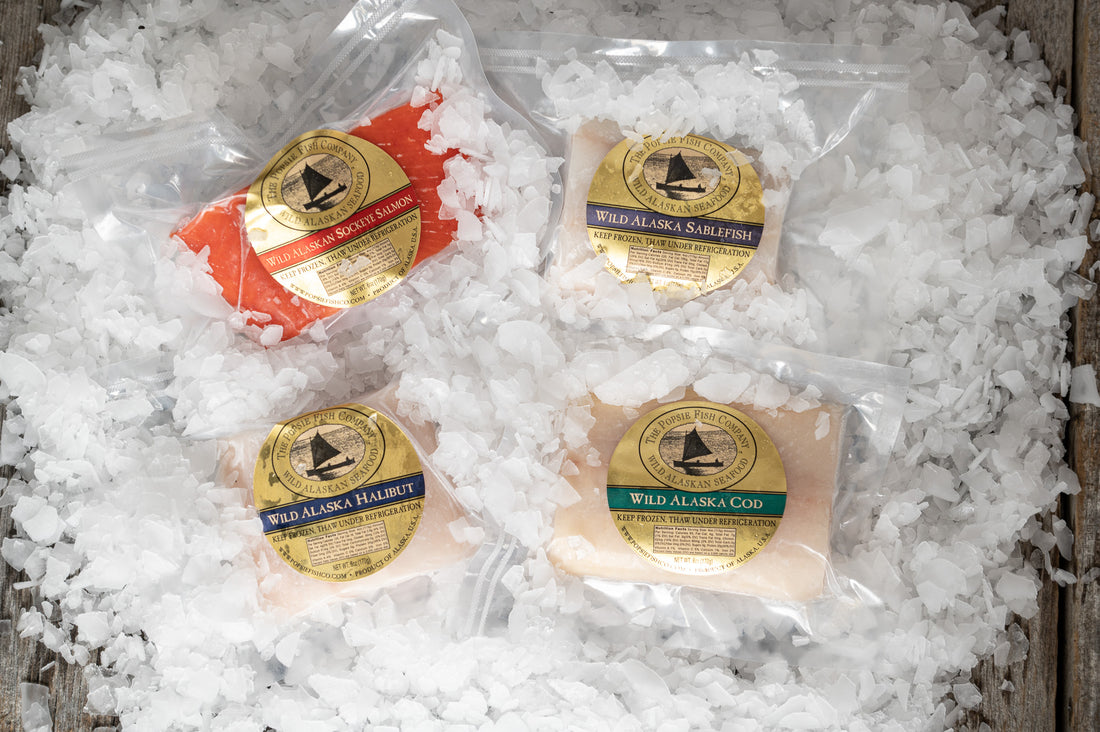
How to Thaw Frozen Fish
How to Thaw Frozen Fish
It is generally recommended that you thaw frozen fish before you cook it, because thawing results in a more consistently-cooked product and reduces the cooking time. If the exterior cooks faster than the interior, then you may have an issue with the outside getting dried out or even burning, the inside being raw, or both at the same time.
Proper thawing methods ensure the safety of the fish, allow for the preservation of its flavor and texture, and reduce the prep and cooking time needed.
Refrigerator Thawing
Most experts recommend that you defrost fish in the refrigerator. This allows for the slow and equal warming of the fish. It avoids temperature fluctuations and you end up with fish that is perfect for almost any dish.
If your frozen fish has been professionally vacuum-packed, you may leave it in its packaging and simply place it the refrigerator to defrost. However, to be completely safe, it is best to remove the fish from the original packaging. Because toxins can grow in an anaerobic (no oxygen) environment at temperatures above 38 degrees F., it is best to remove the fish from the packaging to expose the fish to oxygen and prevent any problems. Just place the fish in a bowl or shallow pan to catch any frozen water or other liquids that may run off. Leave it overnight, for 8-12 hours, if you have thin fillets or portions. With larger pieces, and especially with a whole fish, it may take two overnights to completely thaw.
Cold Water Thawing
Another option is to use cold water to thaw the fish instead of thawing in a refrigerator.
If your fish has been professionally vacuum-packed, you may leave it in its original packaging to thaw it with cold water. If you have any doubts about the integrity of the packaging, your best bet is to remove the fish from its original bag and seal it in a strong waterproof bag, such as a freezer-rated zipper storage bag. Be sure to eliminate as much air as possible. Then place that bag in a pan and immerse it in cold water. You may need to place an object such as a small glass jar on top to keep the fish submerged, completely surrounded by the water.
Every thirty minutes after this, you should change out the water to ensure that the water remains cool. You may have to do this several times, depending on the thickness of the fish.
Thawing in cold water works faster than thawing in a refrigerator because water is a much better temperature conductor than air. The coolness of the water moves into the fish faster than the coolness of the air in a refrigerator.
Microwave Thawing
We do not recommend defrosting fish in the microwave because it does not thaw the fish consistently throughout the varied thickness of the fish, and because it's easy to accidentally and unevenly cook the fish using this process. However, if you insist . . !
To thaw in the microwave, remove the fish from its packaging, brush off any observable ice crystals, and place on a paper towel-lined, microwave-safe plate. Do not cover or place it in a sealed container, as that can cause any steam that is created to cook the fish.
Turn down the microwave to around 30% of its full power. If it has a "defrost" setting, use this instead. Defrost does not reduce the power it puts out, but instead activates and deactivates the microwave element in the device over time. This helps prevent the food from cooking.
Start microwaving the fish, on defrost or low power, in short bursts of 1-2 minutes each time, depending on the size of your fish. If it is small, start slowly! After the microwave stops, remove the fish from the oven and check for signs of thawing. You want to stop while the fish is still cold, but not frozen. You do not want your defrosted fish warm at all, because that will mean it has started to cook.
And next time, remove the night before and thaw in the refrigerator!
Our Recommendation
For a combination of speed and consistency, we recommend cold water thawing. This allows you to have food on the day you decide you want it, but does not run the risk of cooking it like in the microwave.
No matter your method, to ensure it receives the same effect on all sides, remember to flip, rotate, or stir the fish during the process. This can promote faster thawing and consistent temperatures throughout the fish.
You could also cut the fish into smaller pieces. This will allow more of it to receive warmth from the outside faster.
How to Cook Frozen Fish
While most people prefer to cook fish after it has thawed, several frozen fish recipes do exist. These take into account the difficulties in thawing and allow people to enjoy this meat without needing a long time to prepare beforehand.
What you need to make sure, though, is that the fish is done by the end. Before you serve it, remember to check the inside of the fish to ensure it is not still raw on the inside. But remember also that the residual heat remains with the fish for some time after it has been removed from the stove or the oven, and that will continue to cook the fish.
Benefits of Cooking from Frozen
You can reduce fish cooking times several fold by using frozen fish instead of thawing. As seen above, some of the thawing processes can take up to two full days to finish. Instead, by cooking straight away you do not need to engage in any advanced planning, so this is perfect for busier people.
Most fish is frozen as soon as the fish emerges from the water, retaining its freshness. If you thaw it, you might leave it in a refrigerator for up to two days, losing some of that freshness. Cooking straight from frozen thus means you can have the freshest experience and helps the food retain many of its positive qualities.
For those who are a little more forgetful, cooking from frozen can also help you avoid wastage. We have all had an experience where you have left something to have later in the refrigerator, only to forget about it until it is no longer edible. This can even happen when thawing food, as you may prepare a whole other meal before realizing there is fish available.
Last of all, cooking from frozen creates less mess. You do not need pans, containers, plastic wrap, or anything else you would need to use during the thawing process.
Preparing Frozen Fish
Before you start cooking from frozen, ensure that the fish is well-kept. Inspect the packaging and the fish itself to check to see if it is free from damage or thawing. If it has thawed in part, you may have to be careful when cooking as well as be wary of the safety of the fish if it has sat unfrozen for long.
First of all, remove the fish from its packaging and rinse it off. This will remove ice crystals from its surface, although is an optional step as it could affect the fish's texture. If you do, make sure to then pat it dry with a paper towel to remove any excess water.
If you choose to marinate the food, you may have trouble getting the marinade itself into the fish. As such, we recommend massaging the marinade into it or using a vacuum sealer to press all sides of it while it is still frozen. Of course, you should not leave this for too long or the fish will start to thaw, and you may want to opt for seasoning instead.
Baking Frozen Fish
Start by preheating the oven to 375°F. This is on the low end of the baking scale but will allow the heat to infuse the meat rather than burn the outside.
Make sure to have a baking tray or dish of the right size for the frozen fish. Also, remember you can oil it or use parchment paper to prevent the fish from sticking to the tray.
As you cook the fish, monitor it with care. As with all these methods, ensure it is cooked throughout before you serve it, and return it to the oven if it is not ready. A single fillet should take about 50% longer than when cooking unfrozen fish, depending on the recipe.
Pan-Searing Frozen Fish
Using medium heat, allow the pan to heat up before placing the fish on it. This will guarantee even cooking throughout the fish and allow the fish to sear. Make sure to also use a little bit of cooking oil or butter and coat the surface as much as possible to avoid sticking.
Place the fish, skin-side down, and start to cook. While you would not usually do this with a fresh fillet, you can even put a lid on the pan to help the fish thaw as you cook it.
After around 6 minutes, flip the fish to its other side. When cooked on both sides, check its internal temperature or split it to look inside. If it is still raw, run through the cooking again, checking it is done all the way through before serving.
Grilling Frozen Fish
When grilling frozen fish, you should pre-heat the grill to medium-high as with pan-searing. Remember to oil the grates of the grill to ensure the fish does not stick as it thaws, and place the fish on top.
If you can, close the grill as you start to cook. This will ensure the fish heats evenly across its surface and also keep in any moisture, preventing it from drying out.
As with other methods, grilling will take a little longer with cooking from frozen. As such, aim for around ten extra minutes for each inch of thickness in the fish. Of course, watch the fish if possible to make sure it does not burn on the outside before you serve it as a delicious meal.
You should be aware that if you grill frozen fish, it may have a less-firm texture than with other methods. So long as it is cooked through, this is fine and should not suggest it is raw.
Frozen Fish Sushi
Another option is to use frozen fish to produce sushi. While many people prefer the texture of unfrozen fish, freezing has many benefits.
Also, of course, we do not recommend you use the fish for sushi while it is frozen. You should instead use one of the thawing methods described above.
For example, if you freeze fish to a low enough temperature, you can ensure you kill off any parasites that might exist within it. You can then enjoy it as a safer option.
Frozen fish is also better for those who want to enjoy sushi in the off-season period. While there may be slight differences in flavor and mouthfeel, having wild-caught fish all year round is its own reward.
Find the Best Fish to Use
With all the above advice, you might now be ready to use frozen or thawed fish to create something truly wonderful. If you have not bought any yet, for any reason, we can help you get exactly what you need.
Our supplies of wild-caught fish are available to people all across the country. We ensure our sources are both trustworthy and sustainable to provide the best quality for you. So, check out our shop today and search for something for your next meal.
